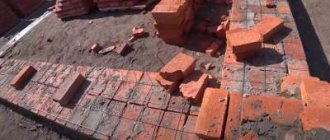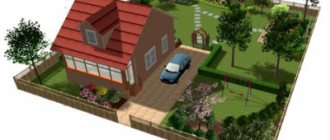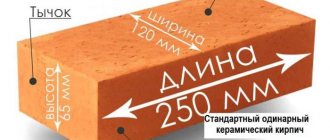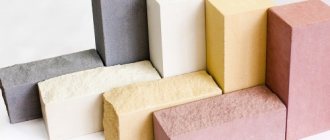Like thousands of years ago, today brick is the most important (and sometimes irreplaceable) material in the construction of houses. Since then, its manufacturing technology has undergone significant changes, as progress does not stand still.
Brick country houses look noble and beautiful. This material allows you to do without external finishing and provides the protective properties of the building. To better understand the benefits of brickwork, you should delve into the construction technology itself. The quality of the structure depends on the type of brick, the options for laying it and the cement mortar used in the process.
In this article we will talk in detail about the nuances of building brick houses, consider the technology of masonry, strengthening brick walls, making partitions and other points that may interest you.
Brick in the interior: advantages and disadvantages
Before deciding to use brick in the design of your home, it is worth studying all the pros and cons of this material: alas, it is not suitable for everyone.
Brick wall in the interior of an apartment
The advantages of natural brick include the following:
- fire resistance - since this material is made of clay or sand, fire cannot damage it;
Using bricks you can decorate a wall with a fireplace
- environmental friendliness - the natural composition is hypoallergenic and safe, therefore suitable even for children's rooms;
Brick wall in the interior of a children's room
- anti-vandal properties - durable blocks are extremely difficult to damage mechanically;
Brick walls from floor to ceiling
- durability - after many years the masonry does not wear out and over time begins to look even more interesting;
Suitable here
×
Floor lamp Arco 2 EL005
31 200 rub.
buy
Raw brick wall in the interior
- possibility of painting - the color of the material can easily be changed using paint if the original shade does not fit into the interior;
Painted brick wall in the interior of the room
- spectacular appearance - a brick wall looks in the room as a fresh and original accent.
Decorative brick wall in an apartment
However, brickwork also has its disadvantages, which include:
- heavy weight - since this material is very heavy, it is not suitable for use in old buildings with wooden floors, and is also not recommended for decorating balconies and interior partitions that are not load-bearing (without preliminary analysis of the strength of these structures);
Suitable here
×
Designer chandelier Burst black 10163-8L
9 860 rub.
buy
Massive brick wall in the living room
- high cost - natural brick and mortar for it are much more expensive than other finishing materials;
Suitable here
×
Round mirror in black frame 91 cm Hub
15 750 rub.
buy
Accent brick wall in the interior
- long construction process - creating beautiful masonry requires a lot of time, which significantly increases the repair time;
Decorating walls with bricks in a studio interior
- installation is problematic - this material is difficult to handle if you do not have the appropriate experience, so such finishing will require the involvement of a professional;
Fragment of a brick wall in the interior of a room
- instability to dirt - the porous structure quickly fills with dust, and therefore requires regular and frequent cleaning.
White brick wall requires regular and frequent cleaning
Decorative plaster - stylish and safe
Decorative plaster to create a brick texture has been practiced for a long time. Today, only gypsum bricks cast in special molds can compete with it in terms of the convincingness of the relief. However, if your hands are not growing from a place that allows you to achieve a perfectly even finish, then it is best to use plaster.
What you will need
- starting plaster for the base;
- construction mixer;
- thick thread to create grooves;
- jointing or carpenter's chisel;
- sandpaper;
- sample of a foam brick 6*12.5 cm.
Algorithm of actions
- after the plaster is diluted with water and brought to the desired thick consistency with a mixer, a layer should be applied to the wall; Using a narrow spatula, scoop the solution from the container and apply it to a wide one - then lean it exactly against the wall, keeping it parallel, and spread the plaster;
- gradually fill the entire wall - there is no need to be overly concerned about evenness, since an overly even relief will seriously affect the naturalness of the artificial masonry;
- using a ruler, measure 6-7 centimeters from the ceiling level and tighten the thread - for this you need the help of at least two more people;
- grab exactly the middle of this thread, pull it towards you and release it - it will hit the wall and form a fairly even groove;
- repeat this operation until you reach the baseboard itself;
- leave the wall to dry for half an hour;
- take the jointing and use it to remove excess material from the resulting horizontal seam;
- vertical seams can be beautifully highlighted with a pre-cut foam brick of a standard size, placing it between the horizontal seams;
- At the same time, do not forget about the displacement of the brickwork;
- a few days after applying the plaster, you can sand the edges of the seams with sandpaper, achieving a harmonious rounded effect;
- the final touch is painting to suit your taste, do not forget about the seams - they need to be highlighted either with a contrasting color, or made a shade darker or lighter.
One of the advantages is the absolute undemandingness of the straightness of your hands, since the naturalness of the masonry is at the forefront, and it, as you know, is far from strict geometry.
Types of brickwork in the interior
There are more than a dozen types of brickwork, but only three of them are most often used in interior design.
Textured brick wall in the interior of the room
1. Spoon. The most common option: with this type, each subsequent row is laid with an offset of half or a quarter of the length of the brick.
Spoon-type brickwork in the interior
2. Cross. In this installation option, the rows of bricks alternate: first there is a row laid out with the long side, above it with the short side, then again with the long side, and so on.
Cross-type brickwork in the hallway interior
3. Chaotic. Bricks laid on the short side appear in chaotic patches among long blocks. This option is quite rare: most often it can be seen in old houses.
Chaotic brickwork in the living room design
When laying materials that imitate natural brick (for example, flexible tiles or clinker), you can create the effect of a cross or chaotic masonry by cutting the cladding elements in half and alternating them with standard ones.
Imitation of cross brickwork using wall panels
Selecting a material to create an imitation
The further course of action directly depends on what material you will use to imitate brickwork. You have a choice:
- wallpaper and paint;
- gypsum;
- decorative panels;
- decorative plaster.
Of all the proposed options, the use of decorative plaster
allows you to obtain the most flawless material in terms of imitation.
However, be prepared for the fact that you will have to tinker a lot. Beauty, as you know, requires sacrifice. And funds, by the way, too. For all other methods, there are questions regarding how convincing the brickwork designed in this way looks. So, the option with wallpaper and paint seems to be the cheapest and most unpretentious, but it takes a lot of time with a rather modest result.
It will be a little easier with decorative panels, but this method works only with a plasterboard surface, which can offer you a perfectly flat surface.
A few words about gypsum
. If you have special silicone molds, you can cast the necessary bricks, dry them thoroughly and lay them out in exactly the same way as craftsmen lay tiles. However, you can do without them. This method of simulating brickwork on a wall will also be discussed below.
Decorating brickwork
A bare brick wall is an attribute of industrial buildings, so in itself it can look cold and uncomfortable. To avoid this, you need to decorate it with various little things that create a homely mood. Suitable for these purposes:
Decorative design of a brick wall in the interior
- paintings, especially bright abstractions and minimalist options;
Painting for decorating a brick wall in the living room
- spectacular mirrors in an unusual frame;
Original mirror for brick wall decoration
- laconic posters and photographs in simple frames;
Decorating a brick wall with bright posters
- decorative animal heads;
Decorative deer head for brick wall decoration
- original sconces - in the form of lanterns or complex geometric shapes.
Geometric lamps for brick wall decor
Visual effects: how to influence the perception of space?
A wall made of traditional red brick is not the only possible option. The texture of the material and the laconic form of individual elements allows you to influence the perception of space. How to do it?
White wall
This option is used so often that it requires separate mention. Texture combined with white creates a good background for placing bright accessories.
White wall in the kitchen
The versatility of the shade allows it to be used in any room as the main design or to highlight individual zones. In white it is even possible to decorate all the walls in the room.
And at the same time the room will not look gloomy and basement. On the contrary, a light shade “adds” free space, making the room visually larger. Most often this technique is used when decorating bedrooms and kitchens.
Looks good in any room
Painting it white makes the design modern and dynamic.










